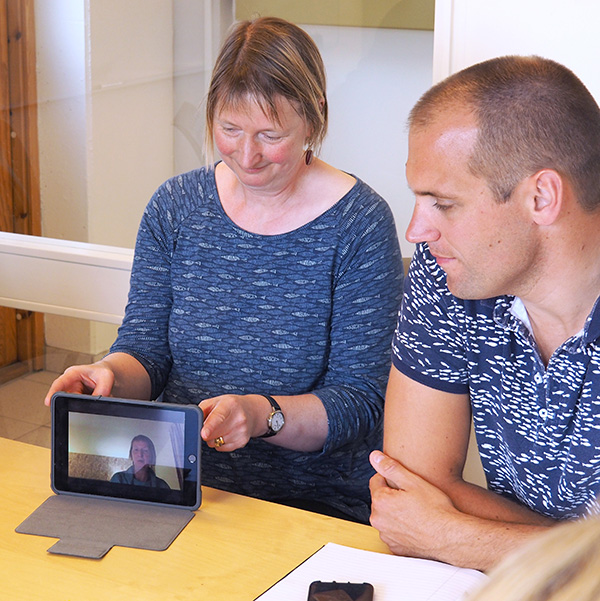Supporting Do-It-Yourself video-based teachers’ professional learning

Educating teachers for innovative education: Every day is different, every school is different
March 5, 2020
How Corona relates to educational change: An impetus for ICT-based teacher education
May 12, 2020Supporting Do-It-Yourself video-based teachers’ professional learning

Focus on short videotaped episodes, find critical moments and examine them through predefined perspectives. These are the core instructions of a Do It Yourself (DIY) tool for analyzing self-filmed classroom videos currently being developed.
Many teacher educators consider classroom video to be an important resource that supports high-quality professional learning (Marsh & Mitchell, 2014). Videos provide rich data, and are easily filmed with smartphones. However, analyzing the videos is a challenge. Therefore, I have designed an online course aimed at supporting teachers in conducting self-video-based inquiry cycles consisting of:
1. Identifying challenges of practice and choosing one challenge to focus on,
2. Formulating questions of inquiry,
3. Videotaping oneself while addressing the chosen challenge,
4. Analyzing the video to understand how to tackle the challenge in a better way.
The course supports the video analysis with a tool that I have created, based on my personal experience as a teacher and teacher educator, and on observations of other teacher educators. It focuses attention on critical issues arising from any classroom video, without suppressing users' independent thinking when interpreting the video. The tool focuses on ten aspects of teachers' practice. It does not provide criteria for successful performance and does not define any desired outcomes (e.g. students' involvement or relevance to students' lives), leaving it up to the teachers to decide which outcomes they expect, and how to evaluate themselves. It informs teachers' professional vision (Sherin & van Es, 2009), but by no means presumes to define best-practice. The ten aspects are:
1. Lesson flow: The flow should reflect the lesson's content, while accommodating our students' needs. When observing the lesson, we examine how activities were ordered, and whether certain activities were missing.
2. Rules: Rules define the limits of legitimate behavior in the classroom. When observing them, we look for what we defined as legitimate or illegitimate, how we introduced the rules, how students reacted to them and how we reacted when students broke them.
3. Organizing the classroom environment: The environment can support specific learning activities we lead. We can examine the environment in which we taught (classroom or other), how we organized the physical surroundings and the students in it.
4. Explanations: When teaching, especially knowledge that is new to our students, we allocate a lot of time to providing and explaining information. Observing how we did so, enables us to examine our accuracy in details, the clarity of our explanations, our use of demonstrations and illustrations and our enthusiasm and passion towards knowledge.
5. Questions: Questions can influence the content of classroom discussions, students' involvement in it and create learning opportunities for them. When observing, we can examine the type of questions we asked (e.g. encouraging Higher or Lower Order Thinking), how much wait-time we provided, which content our questions referred to and how students reacted to the questions.
6. Reacting to students: Like our questions, our reactions have a strong influence on classroom discussions and students' learning. Observing them, we can ask ourselves when and why we reacted – or refrained from reacting, what was the nature of our reactions, how open were we to creative ideas and how we responded to mistakes. We will examine how our reactions affect our students.
7. Terminology: Terminology can help us understand each other and support learning. In observing our teaching, we examine whether the terms our lesson focuses on were used accurately and clearly (both by us and by the students), and whether we made sure that the students understood these terms.
8. Illustrations: There are countless types of illustrations teachers use to support students' learning (experiments, educational tours, videos etc.). Each illustration is used differently, but for all of them, we can examine how we used them, for what purpose, what types of knowledge and understanding they represented and how our students reacted to our use of illustrations.
9. Whiteboard: The whiteboard is (probably) the most common illustrative tool teachers use. But in addition to illustrating, it allows us to capture parts of the classroom conversation in real time and present them for further discussion. When observing our use of the whiteboard, we can ask ourselves about the content we wrote on it and why, how we arranged it, how its order reflected the content, and how the content and order on the whiteboard relate to the lesson content and represent a deep understanding of it.
10. Learning tasks: As teachers, we ask our students to perform tasks that are intended to improve their learning (read, write, answer questions, discuss in groups etc.). Observing our use of tasks, we can ask how we instructed students to perform them, what was the learning content they address, how they addressed it (e.g. solicit Higher or Lower Order Thinking), the conditions we provided our students for achieving the task goals and how students performed them.
References
Marsh, B., & Mitchell, N. (2014). The role of video in teacher professional development. Teacher Development, 18(3), 403-417.
Sherin, M. G., & van Es, E. A. (2009). Effects of video club participation on teachers' professional vision. Journal of teacher education, 60(1), 20-37.




